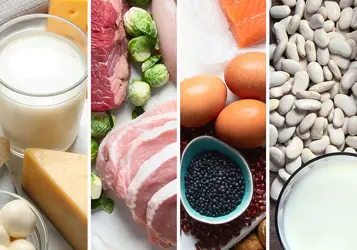There’s consensus that the climate crisis we face is existential. There are 7.7 billion of us, so how do we feed ourselves sustainably?
Our food system is coming under scrutiny because what we eat has environmental impacts that extend beyond our own body. Many consumers are now making choices based on how environmentally friendly they perceive products to be, and it’s a trend that’s likely to escalate.
A key part of this trend is a flourishing movement towards depending exclusively on plant foods, even for protein. That’s because although animal foods are protein-dense, they are believed to have higher environmental impacts. But people still care about their health and nutrition. And it’s been extremely difficult for the average consumer to simultaneously weigh both the nutritional quality and the environmental impact of a food – until now.
Hunting for a sustainable diet
Aware that protein is a key component of our most resource-intensive foods and also a vital nutrient for human health, our research team at Arizona State University conducted an evidence-based study of the global warming potential of protein sources that also took into account the quality of protein provided. The aim was to rank the foods based on their efficiency at offering the most benefit from protein at the smallest environmental cost.
Our results were unexpected – even disruptive, we think – because some animal proteins, especially whey, ranked better than plant proteins in terms of the amount and quality of protein they provide for their greenhouse gas buck. We were surprised that our ranking showed that it is possible to achieve a diet that includes selected animal products yet can still have a lower impact than the fare of a committed vegan, like myself, when the quality of protein is considered as part of the metrics used.
What we did differently – and why
The novel difference between our study and previous studies is that we accounted for both the quality of the protein and the usual serving size in addition to the quantity of protein. Let me explain how we performed this analysis.
First, we analysed each protein source’s environmental impact using already published life cycle assessment (LCA) data. These assessments analyse the greenhouse gas emissions of products, ideally from “cradle to grave” but frequently from “cradle to gate”. Typically, these LCA studies evaluate impacts on a weight basis.
Second, we created an algorithm to account for protein quality because protein is absorbed differently depending on the amino acids present. Not all protein is equal in terms of how digestible and bioavailable its essential amino acids are – and these are, of course, the point of eating protein in the first place. In LCA terminology, this would make the amino acids an “obligatory property”, which is the basis for establishing a “functional unit” that forms the basis of comparison across competing products. This is why we used the digestible indispensable amino acid score (DIAAS) to examine how amino acids are digested and assimilated by the body as a metric to understand protein quality. Additional methodological details are available in our paper.
So while protein sources are often ranked in terms of how much protein they contain per 100 grams, what matters nutritionally is the amount and type of amino acids our bodies can absorb from the food. We therefore took this bioavailability into account, noting that the protein from plants is generally less bioavailable than animal proteins.
Third, we took into account the customary serving size for each protein source. Serving size has a direct effect on environmental impact: smaller servings have lower impacts. It isn’t meaningful, for example, to compare 100 grams of salmon with 100 grams of wheat when these don’t reflect the quantities that people eat in the real world.
When pork beats lentils
We found that peanuts, dry whey and soy protein isolate were most efficient at delivering protein with a small environmental cost, while bread, rice and beef were least efficient.
It was a bit of a shock to discover that dry whey, a dairy product that relies on production through animals, was almost the most environmentally-efficient protein source. We had excluded milk and other liquid foods from our study because its high water content and large serving size weight distorted its usefulness in our algorithm.
In between lay other surprises: the protein in tofu comes with a heavier greenhouse gas footprint than pork, and chicken’s protein offering is more climate-friendly than that of lentils!
The reason for this is that animal protein is dense and highly bioavailable, raising its DIAAS score. A given weight of wheat flour, for example, has much lower global warming potential than the same weight of pork, but flour also has much lower protein content and bioavailability. So to match the protein content and DIAAS score, much more wheat than pork would have to be consumed, making wheat flour’s global warming potential higher in this context.
Processing matters
Similarly, some proteins embody energy required for processing that can be unexpectedly high. Protein-rich foods have two major global warming contributors: On-farm factors, such as fertilizer and gas emissions for crops or livestock feed, and the energy for processing and manufacturing. The latter can be higher than many people realise.
Being fair and equal
Another factor that influences the global warming potential of a food is its production method. We accounted for this by taking data from a range of production systems where possible, including conventional and organic. We were limited at times by the LCAs we could obtain, and we’ve been transparent about that in the supplementary information to our paper. For example, several foods included only had one LCA data source available, and methodology across different LCA studies was not always identical. That document also lists which countries our data came from; most of our sources were European, although we looked wider where necessary – to Thailand for grasshopper protein information, for example.
Another detail provided is how the studies we used handled allocation of environmental burdens in systems that produce more than one output, which is typically through economic- or mass-based allocation, but also sometimes through system expansion. For example, cows can be the source of beef, cheese, milk and whey, so their estimated environmental impact has to be split across outputs of their production system. Again the limitation of data availability meant we used sources with different allocation methods.
Looking for more transparency
As consumers’ concern grows about how their choices influence climate change, it’s likely that more researchers and food producers will assess the global warming potential of foods. We welcome this because it means that evaluations such as ours will be even more meaningful as we can draw from a more comprehensive pool of evaluations, which will in turn provide better information to help concerned consumers choose what to buy and eat.
In the meantime, our study shows that it’s time to be smarter about how we measure protein efficiency and sustainability. Empirical investigations can produce results that challenge our assumptions, and if there’s one thing climate science is showing us, it’s that we need to find new ways of doing things.
This blog contains material and information intended for B2B customers, suppliers and distributors, and is not intended as information to the final consumers.
























